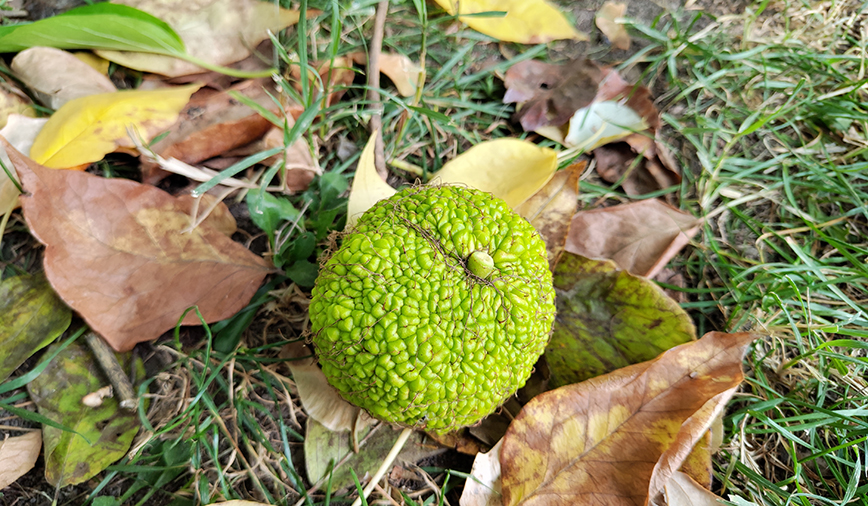Pam’s Perspective
Pam Otto is the Manager of Nature Programs and
Interpretive Services for the St. Charles Park District
(Continued on Page 2)
Deck the halls with boughs of…hedge apples?
I couldn’t believe it but, yup, there they were. Hedge apples, or osage oranges, entwined
throughout the holiday garland at the St. Charles Park District’s Baker Community Center.
Although this naturalist is no Martha Stewart, her famous phrase immediately came to mind. “It’s
a good thing,” I said to the fruit. Out loud.
A fascinating plant with lore galore, osage orange is a ubiquitous part of our former-farmland
landscape. Sturdy and stalwart, it’s a relic of a bygone era. Yet it is often overlooked. The species
is native to the United States, but not Illinois, so most natural area managers scoff at it. And
landowners whose property is lined with osage orange often curse the tree for its skin tearing,
and tire puncturing, thorns. But if you’re into plants with rich cultural history—not to mention
unique decorating potential—well then, osage orange may be
just the tree for you.
Thousands of years ago, when megafauna walked the land,
osage orange was part of the scenery, right alongside critters like
mastodons and giant ground sloths. In fact, it’s theorized that
these animals were some of the primary dispersers for osage
orange seeds way back then.
Apparently, though, they didn’t roam far, because the tree’s
native range was, and is, confined to eastern Texas, plus parts of
Oklahoma, Arkansas and Louisiana. But if you were to set about
doing an osage orange survey today, you’d find this rugged tree present in all 48 contiguous
states, plus parts of southern Canada.
About 150 or so years ago, osage orange became THE tree to have. The Osage Native Americans,
who’d earlier discovered that the tree’s wood made the best bows EVER, introduced pioneers to
the versatile plant. These settlers in turn planted the trees as windbreaks to slow soil erosion
caused by the prairie’s prevailing winds, and to serve as the fencing they needed to contain
roaming cattle.
The trees were planted close together, in a row, and their tops were cut off so they’d grow
shrubby instead of tall. The plants’ prickly, sinuous branches would, over time, knit together to
form an impenetrable hedge that was “horse high, bull strong and hog tight.”
When barbed wire came on the scene, in the late 1860s and early ’70s, it could have spelled the
end of osage orange’s popularity. But because fence wire is useless without fence posts, and
because osage orange wood resists rot, insects and sun damage, the tree’s use remained high.
Pam’s Perspective – Page 2
Have you ever looked at an old wire fencerow? Did you notice how many of the posts are downright
crooked? Chances are these are made from osage orange. The tree’s twisty, knotted growth habit makes it
unsuitable for use as planks, but excellent for fence posts, wagon wheels and bow staves.
Its wood is remarkable, but osage orange’s namesake fruit—the highlight of the Baker Center’s Christmas
display—is pretty amazing in its own right. Big as a grapefruit and safety green in color, it goes by many
names, including hedge apple, horse apple and monkey brains. It has a light, citrusy smell, and is used by
some folks as a natural insect repellent.
The fruit’s flesh is milky and bitter tasting, palatable to giant ground sloths but not too many other critters.
However, some horses like them, and determined squirrels will chew through the pulp to get to the seeds—
as many as 200 per orange/apple/brain—which have a mild and not at all unpleasant taste.
Because osage orange is dioecious, that is, its male and female parts are on separate plants, not every tree
produces fruit. Only females will.
Speaking of, a female of another species is who was responsible for the exquisite use of osage orange in the
Baker Center arrangements. Park District horticulturist Sharon Hanson collected the fruits this year, as she
has in past years, from area hedgerows and roadsides. Then, working with hort colleagues Brian Welz, Percy
Williams and John Hildebrand, the decorations were placed on light poles, window boxes and planters.
The arrangements, which include lots of other locally harvested materials too, will be on display until after
New Years. If you get a chance, stop by and see how many different plants and plant parts you can identify.
I’ll bet there’s at least one you’ll know, now.
And that’s a good thing.
Pam Otto is the manager of nature programs and interpretive services. She can be reached at 630-513-4346

